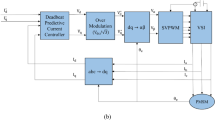Abstract
The main and, in real conditions, the only way to protect synchronous motors from voltage losses during a fault is a self-starting method. This method is widely used in industry, in particular, in petrochemical production. In this context, the role of simulation accuracy of the self-starting method for powerful synchronous motors as a part of real power system is considered. In the paper, a three-phase simulation of a large petrochemical enterprise is presented. Interruptions of synchronous motors of water pumps at such enterprises are not allowed; hence, two self-starting methods for powerful synchronous motors applicable in real power system are considered. The first self-starting method is used after a significant decrease or loss of bus voltage due to nearby fault. The second is used after interruption of power supply due to operation of automatic transfer switch or automatic reclosing; at that moment, the synchronous motors are disconnected from the power source for a certain time. This period of time is required for automatic transfer switch or automatic reclosing operation. According to the simulation results, settings of relay protection and emergency automatics of powerful synchronous motors have been changed.










Similar content being viewed by others
References
Hammons T, Winning D (1971) Comparison of synchronous-machine modelsin the study of the transient behavior of electric power system. In:Proceedings of the IEE, vol 118, pp 1442–1458
Computer analysis of power systems working group of the computer andanalytical methods subcommittee-power system engineering committee (1973) System load dynamics-simulation effects and determination ofload constants. IEEE Trans 92:600–609
Concordia C, Schulz R (1975) Appropriate component representation for the simulation of power system dynamics. In: Proceedings of IEEE Power Eng. Conf. Pap. Winter Meet, pp 16–23
Undrill J, Casazza J, Gulachenski E, Kirchmayer E (1971) Electromechanical equivalent for use in power system stability studies. IEEE Trans. Power Appar. Syst. 90:2060–2071
McCauley T (1975) Disturbance dependent electromechanical equivalents for transient stability studies. In: Proceedings of IEEE Power Eng. Soc. Conf. Pap. Winter Meet, pp 11–19
Gusev A, Suvorov A, Sulaymanov A (2015) Development concept of guaranteed verification electric power system simulation tools and its realization. MATEC Web of Conf. 37. doi:10.1051/matecconf/20153701023
El-Shibini M (1974) Simplified model for dynamic stability studies. Arch. Electrotech 56:272–277
Darwish M, Fantin J, Grateloup G (1977) On the decomposition aggregation of large scale power system. Automat. Contr. Theory Appl. 5:18–25
Undrill M, Turner A (1977) Construction of power system electromechanical equivalents by modal analysis. IEEE Trans. Power Apparatus Syst PAS–90(5):2049–2059
Neamt L, Matei O, Chiver O (2015) Optimised methodology for stepper motor simulation. In: Proceedings of IEEE 15th International Conference on Environment and Electrical Engineering, Rome, Italy. doi:10.1109/EEEIC.2015.7165315
Mahanta U, Patnaik D, Panigrahi B (2016) Dynamic modeling and simulation of SVM-DTC of five phase induction motor. In: Proceedings of 2015 International Conference on Energy, Power and Environment: Towards Sustainable Growth, Shillong, India. doi:10.1109/EPETSG.2015.7510062
Makarov Y et al (2005) Blackout prevention in the United States, Europe and Russia. Proc IEEE 93(11):1942–1955
Kjolle G, Heggset J, Hjartsjo B, Engen H (2005) Protection system faults 1999–2003 and the influence on the reliability of supply. In: Proceedings of IEEE St. Petersburg PowerTech 2005, Russia, pp 1–6
Atputharajah A, Saha T (2009) Power system blackouts—literature review. In: Proceedings of Int. Conf. Ind. Inf. Syst., pp 460–465
Horowitz S, Phadke A (2006) Blackouts and relaying considerations—relaying philosophies and the future of relay systems. IEEE Power Energy Mag. 4(5):60–67
Gusev A, Svechkarev S, Plodisty I (2004) The problem of power system modeling and the concept hybrid solution. In: Proceedings of 10th symposium in large scale systems: theory and applications, Japan, vol 1, pp 440–445
Borovikov Y, Sulaymanov A, Andreev M (2015) Application of hybrid real-time power system simulator for designing and researching of relay protection and automation. IOP Conf. Series. Materials Science and Engineering, vol 93. doi:10.1088/1757-899X/93/1/012001
Ufa R, Sulaymanova V, Borovikov Y (2015) Intelligent electric power systems with active-adaptive electric networks: challenges for simulation tools. MATEC Web of Conf., vol 37. doi:10.1051/matecconf/20153701061
Ruban N, Gusev A, Sulaymanova V (2015) Real-time comprehensive simulation of electric power systems for the task of overvoltages value determination. IOP Conf Ser Mater Sci Eng 93. doi:10.1088/1757-899X/93/1/012012
Gusev A, Suvorov A, Sulaymanov A (2015) Using controlled shunt reactors for voltage stabilization on the example of real electric power system. IOP Conf Ser Mater Sci Eng 93. doi:10.1088/1757-899X/93/1/012016
Borovikov Y, Gusev A, Sulaymanov A, Ufa R, Vasilev A, Andreev M, Ruban N, Suvorov A (2016) Hybrid simulation model for VSC HVDC. IEEE Trans. Smart Grid 7(5):2242–2249
Andreev M, Sulaymanov A (2015) Platform based on hybrid real-time power system simulator for development and research of intelligent power systems with active-adaptive networks. In: Proceedings of IEEE PowerTech 2015, Netherlands, pp 1–6
Borovikov Y, Gusev A, Sulaymanov A, Ufa R (2014) Hybrid real-timesimulator of power system for advanced simulation of the FACTS andHVDC system based on Voltage Source Converter. In: Proceedings of2nd International Conference on Systems and Informatics, Shanghai, China, pp 148–152
Ruban N, Borovikov Y, Sulaymanov A (2014) Simulation of transmissionlines phase-comparison protection for optimization its settings. In: Proceedings of 9th International Forum on Strategic Technology(IFOST), Cox’s Bazar, Bangladesh, pp 264–267
Suslov K, Gerasimov D, Solodusha S (2015) Smart grid: algorithms for control of active-adaptive network components. In: Proceedings of IEEE PowerTech 2015, Netherlands, pp 95–102
Acknowledgments
The work was supported by Ministry of Education and Science of the Russian Federation under government Grant “Science” (Project No. 3901, Research and development of hybrid model of back-to-back high voltage direct current transmission system).
Author information
Authors and Affiliations
Corresponding author
Rights and permissions
About this article
Cite this article
Suvorov, A., Borovikov, Y., Gusev, A. et al. Increase in simulation accuracy of self-starting motors used for relay protection and automatic equipment. Electr Eng 99, 959–968 (2017). https://doi.org/10.1007/s00202-016-0464-4
Received:
Accepted:
Published:
Issue Date:
DOI: https://doi.org/10.1007/s00202-016-0464-4




